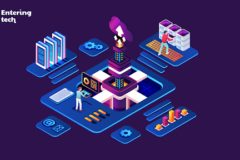
The term ’cloud computing’ has risen in popularity in the tech industry lately, but what does it mean? Cloud computing refers to a new way of delivering computing resources such as servers, storage, databases, networking, software, and analytics over the internet. The idea behind cloud computing is to provide users with access to these resources on-demand, without having to invest in expensive hardware or software.
At its core, cloud computing is all about sharing resources. In traditional computing, a company or organisation would have to purchase and maintain its own hardware, software, and infrastructure. This is an expensive and time-consuming process that requires a lot of expertise and technical know-how. With cloud computing, however, all of these resources are managed by a third-party provider and are made available to users via the internet.
One of the biggest benefits of cloud computing is that it allows users to scale their computing resources up or down as needed. For example, if a company suddenly experiences a surge in traffic to their website, they can easily add more computing resources to handle the increased load. This means that companies don’t have to invest in expensive hardware and software that they may only need for a short period of time.
It also provides users with more flexibility when it comes to accessing their data and applications. Because everything is stored in the cloud, users can access their data and applications from anywhere with an internet connection. This means that employees can work from home or on the go, without having to be physically present in the office.
There are three main types of cloud computing: infrastructure as a service (IaaS), platform as a service (PaaS), and software as a service (SaaS).
laaS
Infrastructure as a service (IaaS) is the most basic type of CC. With IaaS, users are provided with access to virtualised computing resources such as servers, storage, and networking. Users are responsible for managing their own operating systems, applications, and data.
PaaS
Platform as a service (PaaS) takes things a step further by providing users with a complete development environment. With PaaS, users can build, test, and deploy their own applications without having to worry about the underlying infrastructure. This makes it much easier for developers to focus on creating great software without having to worry about the technical details.
SaaS
Software as a service (SaaS) is the most advanced form of cloud computing. With SaaS, users are provided with access to a complete software application that runs entirely in the cloud. This means that users don’t have to worry about installing, maintaining, or updating the software themselves. Instead, everything is taken care of by the provider.
Final thoughts on cloud computing
Cloud computing is a powerful technology that has the potential to revolutionise the way we do computing. It provides users with access to an enormous amount of computing resources, without requiring them to invest in expensive hardware or software. With cloud computing, companies and organisations can be more agile, more efficient, and more competitive.


















